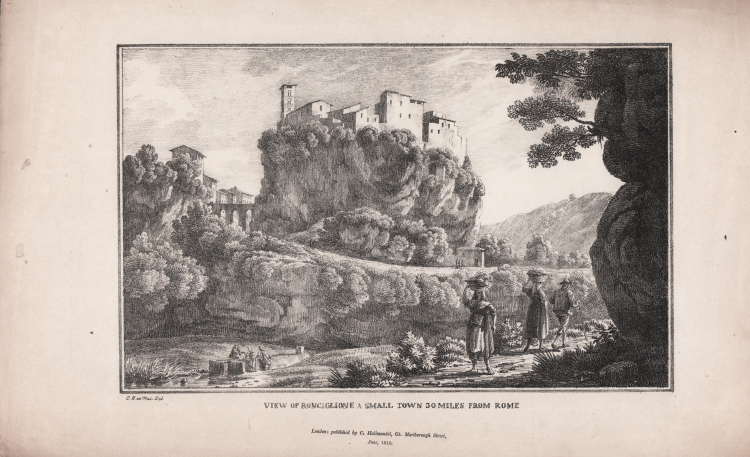



| Reference: | CO-803 |
| Author | Charles Joseph HULLMANDELL |
| Year: | 1818 |
| Zone: | Ronciglione |
| Printed: | London |
| Measures: | 310 x 200 mm |


| Reference: | CO-803 |
| Author | Charles Joseph HULLMANDELL |
| Year: | 1818 |
| Zone: | Ronciglione |
| Printed: | London |
| Measures: | 310 x 200 mm |
View of a church tower and other buildings of the town on hilltop in the centre background, a path below leading to the entrance to the town on the left under a viaduct, seen across a small stream below in the left middle distance where women are washing their laundry in the basin, two women in the right foreground carrying laundry in baskets on their heads, a man also walking beside.
Lithograph, 1818, lettered below image with object title, production detail: "C. H. ex Nat, Del," publication line: "London: published by C. Hullmandel Gt. Marlborough Street."
From Twenty Four / Views of Italy, / drawn from nature, / and engraved upon stone. / by C. Hullmandel. / Published by C. Hullamndel, / 51, Great Marlborough Street. / Price thirty shillings.
The series of 'Twenty Four View of Italy' was published in two volumes in 1818, seemingly in several editions. Abbey Travel 167 lists an edition printed by Moser and Harris.
Bibliografia
Abbey Travel, Travel in Aquatint and lithography 1770-1860 from the library of J.R.Abbey (167.3)
Charles Joseph HULLMANDELL (1789 – 1850)
|
Charles Joseph Hullmandel (15 June 1789 – 15 November 1850) was born in London, where he maintained a lithographic establishment on Great Marlborough Street from about 1819 until his death.
He was born in Queen Street, Mayfair. His father was a German-speaking musician and composer, Nicolas-Joseph Hüllmandel (1756–1823), a native of Strasbourg who became a pupil of C. P. E. Bach and from 1780 spent ten years as a fashionable music teacher in Paris. In 1787 he married Camille-Aurore du Cazan, who was of a noble French family, and in 1789 sent his wife to England, following her in 1790, as the French Revolution unfolded.
As a young man, Charles Hullmandel studied art and spent several years living and working in continental Europe. He learned printmaking and printed many of his own works. In 1818, he set up a printing press in London after a visit to Munich with Rudolph Ackermann, and went on to study chemistry under Michael Faraday for the purpose of improving his printing.
During the first half of the 19th century Hullmandel became one of the most important figures in the development of British lithography, and his name appears on the imprints of thousands of lithographic prints. He developed a method for reproducing gradations in tones and for creating the effect of soft colour washes which enabled the printed reproduction of Romantic landscape paintings of the type made popular in England by J. M. W. Turner. Hullmandel's essay The Art of Drawing on Stone (1824) was an important handbook of lithography. In 1843 he went into partnership with Joseph Fowell Walton (born 1812, living 1863), a cousin of the landscape artist and lithographer William Louis Walton, the firm then becoming known as Hullmandel & Walton.
|
Charles Joseph HULLMANDELL (1789 – 1850)
|
Charles Joseph Hullmandel (15 June 1789 – 15 November 1850) was born in London, where he maintained a lithographic establishment on Great Marlborough Street from about 1819 until his death.
He was born in Queen Street, Mayfair. His father was a German-speaking musician and composer, Nicolas-Joseph Hüllmandel (1756–1823), a native of Strasbourg who became a pupil of C. P. E. Bach and from 1780 spent ten years as a fashionable music teacher in Paris. In 1787 he married Camille-Aurore du Cazan, who was of a noble French family, and in 1789 sent his wife to England, following her in 1790, as the French Revolution unfolded.
As a young man, Charles Hullmandel studied art and spent several years living and working in continental Europe. He learned printmaking and printed many of his own works. In 1818, he set up a printing press in London after a visit to Munich with Rudolph Ackermann, and went on to study chemistry under Michael Faraday for the purpose of improving his printing.
During the first half of the 19th century Hullmandel became one of the most important figures in the development of British lithography, and his name appears on the imprints of thousands of lithographic prints. He developed a method for reproducing gradations in tones and for creating the effect of soft colour washes which enabled the printed reproduction of Romantic landscape paintings of the type made popular in England by J. M. W. Turner. Hullmandel's essay The Art of Drawing on Stone (1824) was an important handbook of lithography. In 1843 he went into partnership with Joseph Fowell Walton (born 1812, living 1863), a cousin of the landscape artist and lithographer William Louis Walton, the firm then becoming known as Hullmandel & Walton.
|